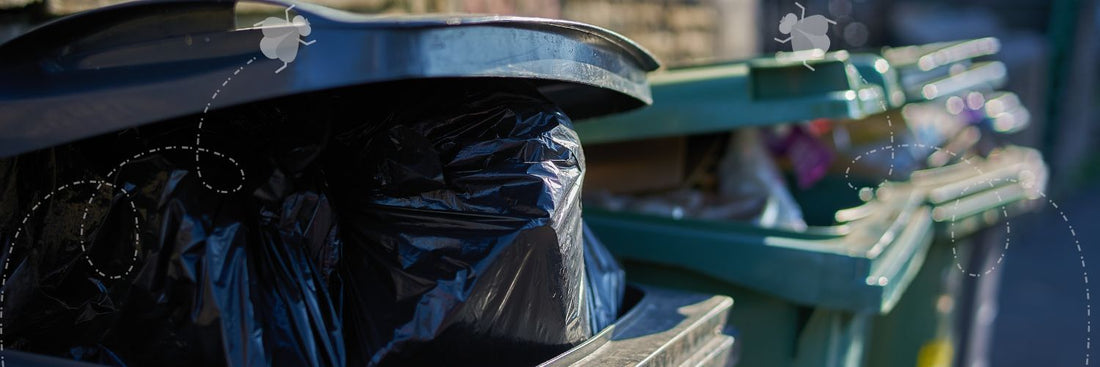How to Stop Flies in Your Wheelie Bin
Let's be honest – there's nothing worse than opening your wheelie bin on a hot Australian day and being greeted by a swarm of flies. It's disgusting, it's unhygienic, and if you've got kids or pets around, it's downright concerning.
If you're battling flies in your wheelie bin, you're definitely not alone. It's one of those annoying problems that seems to come with the territory of living in our beautiful but sometimes brutally hot country. The good news? There are practical solutions that actually work.
Why Flies Love Your Wheelie Bin (And Why It's More Than Just Gross)
Flies aren't just annoying – they're looking for two things: food and a place to lay eggs.
Your wheelie bin is basically a fly's dream home. It's warm, dark, full of rotting organic matter, and often left with the lid slightly ajar. A single female fly can lay up to 500 eggs in her lifetime, and in warm Aussie conditions, those eggs can hatch into maggots within 24 hours.
But here's why this matters beyond the "ick" factor: flies carry diseases. They land on rubbish, pick up bacteria, then land on your kitchen bench or the kids' toys. We're talking about potential exposure to E. coli, Salmonella, and other nasties you definitely don't want in your home.
The Real Problem: It's Not Just About What Goes In
Most advice about keeping flies out of bins focuses on what you put in them. And sure, that's part of it. But here's what a lot of people miss: the biggest problem is often the bin lid itself.
Think about it. You put your rubbish out for collection. The garbage truck comes, empties your bin, and then… the lid stays open. Sometimes for hours. Sometimes for the entire day if you're at work.
That's an open invitation for every fly in the neighbourhood. And if it's rained? You've now got a bin full of water creating the perfect breeding ground.
Even if you're home to close the lid, there's wind. There's animals. There's that annoying way the lid doesn't quite sit flush when the bin's been jostled around.
Practical Solutions That Actually Work
I'm going to give you both quick fixes and longer-term strategies, because everyone's situation is different.
1. Wrap Your Food Waste Properly
This is your first line of defence. Any meat scraps, bones, or particularly smelly food waste should be wrapped in newspaper or paper bags before going in the bin. Some people swear by freezing smelly scraps until bin day – which works brilliantly if you've got the freezer space.
For fruit and vegetable scraps, consider composting instead. Not only does it keep flies away, but you'll get excellent fertiliser for the garden.
2. Use Your Green Waste Bin Strategically
If your council provides a green waste bin (and most do these days), use it for food scraps if they allow it. Check your council's guidelines – many now accept food waste in the green bin, which gets collected more frequently and keeps the smelly stuff out of your general waste.
3. Clean Your Bin Regularly
Cleaning the wheelie bin is nobody's idea of a fun Saturday morning. But giving it a good hose out every month or so makes a big difference.
4. Use Natural Fly Deterrents
Here are some ways to use these scents around your bin:
- Eucalyptus oil: Add a few drops to a cloth or cotton ball and tape it to the inside of your bin lid. Replace weekly.
- Eucalyptus branches: Hang fresh branches near your bins. As an Aussie native plant, it's readily available and works brilliantly.
- Citronella oil: Similar to eucalyptus – use on a cloth near the bin (not directly on rubbish).
- Bay leaves: Scatter dried bay leaves in the bottom of your bin. They're cheap, long-lasting, and flies can't stand them.
- Peppermint oil: Mix with water in a spray bottle and spray around the bin exterior and lid.
- Lavender sachets: Hang these near your bin area – they smell lovely to us but flies avoid them.
Do these work miracles on their own? Not really. But as part of an overall strategy, they definitely help create an environment that flies want to avoid.
5. Keep the Lid Closed
Here's where we get to the heart of the matter. You can do everything right – wrap your waste, clean your bin, use all the natural deterrents – but if your lid doesn't stay closed, you're fighting a losing battle.
The problem is that standard wheelie bins just aren't designed to stay shut. The hinges get loose over time. Wind catches the lid. Animals nudge them open. And after collection, they're often left wide open until you get home to close them.
This is exactly why we created LidStop. It's a simple gravity lock that clips onto your wheelie bin handle and uses flexible resistance to keep the lid shut. The clever bit? It doesn't interfere with garbage collection – the lid can still open when the truck empties it, then automatically closes again afterwards.
No drilling, no complicated locks to unlock on bin night, no hassle. It just works. And for keeping flies out, having a bin that consistently stays closed is genuinely game-changing.
What About Fly Sprays and Insecticides?
You might be wondering about chemical solutions. Here's my take: they're not ideal for wheelie bins. Here's why:
- You're spraying chemicals on something that holds your rubbish, which you need to touch to open and close the lid, and wheel out to the curb for collection.
- These sprays are temporary – you'd need to reapply constantly.
- They're not great for the environment, especially if that chemical-laced water runs into the stormwater drain when it rains.
If you're dealing with a serious infestation, by all means grab the fly spray for a quick fix. But it's not a sustainable long-term solution.
LidStop: The Set and Forget Approach
The best fly prevention strategy is one you don't have to think about every single day. Life's busy enough without adding "check if the bin lid is closed" to your mental to-do list.
This is why I'm a big believer in making physical changes rather than relying on remembering to do things. A gravity lock like LidStop is one of those "install it once and forget about it" solutions that just keeps working in the background.
It helps prevent flies, but it also stops:
- Rainwater filling your bin
- Birds and possums getting into your rubbish
- Odours escaping
- Rubbish blowing out on windy days
LidStop solves multiple problems at once, which is exactly the kind of solution we need.
In Hot Weather, Try These Extra Tips
During summer, fly problems get exponentially worse. A few extra tips for the hot months:
Put your bin in the shade if possible. Even a few degrees cooler makes a difference to how fast things decompose and how attractive your bin is to flies.
Consider putting your bin out later on collection day. If your bin isn't sitting in the sun all morning, that's less time for flies to discover it and fewer hours for smells to develop.
Rinse containers before binning them. That old yoghurt container or meat tray with residue? Give it a quick rinse. It takes a few seconds and makes a real difference.
Use bin liners. Yes, they're an extra cost, but they create a barrier between waste and the bin itself, making cleaning easier and reducing odours.
If I Stop Flies, Will That Also Stop Maggots?
Prevention is about stopping flies from laying eggs in the first place. Here's your complete maggot prevention strategy for Aussie conditions:
- Keep the lid closed at all times – This is the number one prevention method. No flies in = no eggs = no maggots.
- Wrap meat and protein waste – Use newspaper or compostable bags for anything that could attract flies.
- Use bin liners – They create a barrier and make cleaning easier.
- Sprinkle borax or diatomaceous earth in the bottom of your bin – both kill fly larvae.
- Clean your bin monthly – Use white vinegar solution to eliminate odours and any eggs.
- Don't let liquids sit – Drain containers before binning them, and ensure no pooling water in the bin.
- Put bins in shade – Heat accelerates decomposition and attracts more flies.
- Use your green waste bin for food scraps if your council allows it.
In Australia's hot climate, maggots can develop incredibly quickly – sometimes within 24 hours of eggs being laid. This is why keeping flies out in the first place is so critical.
If you're already dealing with maggots, carefully pour boiling water over them. It's instant and effective. Then give your bin a thorough clean with vinegar water and leave it to dry completely in the sun. The UV rays and heat will kill any remaining eggs.
Some people also swear by:
- Sprinkling salt on maggots (dehydrates them)
- Using a mixture of boiling water and white vinegar (double action)
- Leaving the bin open in full sun on a hot day (heat kills them)
After dealing with an infestation, you need to prevent recurrence. This means addressing the root cause – which almost always comes back to flies getting into your bin. A gravity lock that keeps your lid consistently closed is the most reliable prevention method, especially in our climate where the warm weather creates ideal breeding conditions.
The Bottom Line
Keeping flies out of your wheelie bin really comes down to two things: making your bin less attractive to flies in the first place, and keeping them physically out when they do come sniffing around.
You can be diligent about wrapping waste, cleaning your bin, and using natural deterrents. But if your bin lid doesn't stay closed – especially after collection – you're going to be fighting an uphill battle.
The most effective solution is often the simplest: keep the lid shut. Whether that's with a gravity lock like LidStop or another method, a consistently closed bin is a fly-free bin.
Trust me, your future self will thank you the next time you open your wheelie bin on a scorching January day and there's not a fly in sight.

